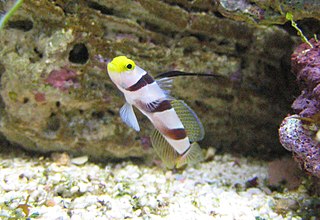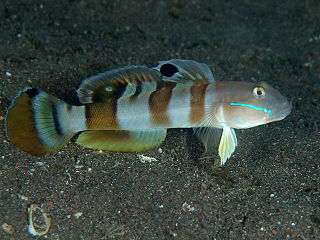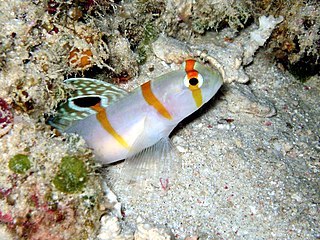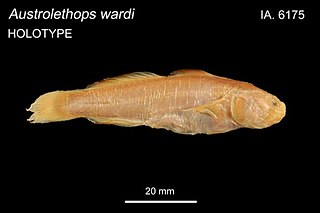
Gobiidae or gobies is a family of bony fish in the order Gobiiformes, one of the largest fish families comprising more than 2,000 species in more than 200 genera. Most of gobiid fish are relatively small, typically less than 10 cm (3.9 in) in length, and the family includes some of the smallest vertebrates in the world, such as Trimmatom nanus and Pandaka pygmaea, Trimmatom nanus are under 1 cm long when fully grown, then Pandaka pygmaea standard length are 9 mm (0.35 in), maximum known standard length are 11 mm (0.43 in). Some large gobies can reach over 30 cm (0.98 ft) in length, but that is exceptional. Generally, they are benthic or bottom-dwellers. Although few are important as food fish for humans, they are of great significance as prey species for other commercially important fish such as cod, haddock, sea bass and flatfish. Several gobiids are also of interest as aquarium fish, such as the dartfish of the genus Ptereleotris. Phylogenetic relationships of gobiids have been studied using molecular data.

Stonogobiops nematodes, the Filament-finned prawn-goby, the Antenna goby, the high-fin goby, the red-banded goby, the high-fin red-banded goby, the striped goby, the barber-pole goby, or the black-ray Goby, is a species of marine goby native to the Indian Ocean and western Pacific Ocean from the Seychelles to the Philippines and Bali.

Valenciennea is a genus of small, bottom-dwelling fish in the family Gobiidae. They are found over sandy bottoms, often at coral reefs in the Indo-Pacific. The members of the genus tend to rest directly on the substrate for extended periods of time. While this is a common behavior for members of the family, this genus also float motionless directly above the substrate, which is why they are sometimes called glider gobies. Their resting behavior has resulted in the vernacular name "sleeper gobies", which invites confusion with the related family Eleotridae. The members of this genus are known to be carnivorous sand-sifters; to eat, they simply engulf entire mouthfuls of sand which they expel through their gills. Specialized structures in their gills filter small crustaceans and worms as the sand is expelled. It is this specific trait that makes some members of the genus attractive to the marine aquarist, and they are often introduced into a marine aquarium for sand-sifting. Some of the species are known to be monogamous. The genus was named after notable French zoologist Achille Valenciennes. These fish are difficult to keep in a tank. Tanks with plenty of live sand and live rock are recommended. Offer foods such as sinking shrimp pellets. Fish may die even if eating properly.

Ctenogobiops tangaroai, the Tangaroan shrimp-goby, is a species of goby of the family Gobiidae, native to the reefs of the Pacific Ocean where it can be found in fine-grained sand patches at depths of from 4 to 40 metres. This species is commensal with alpheid shrimps, with a fish and shrimp sharing a burrow. This species can reach a length of 6 centimetres (2.4 in) TL. It can also be found in the aquarium trade.

Valencienna sexguttata, the chalk goby, sixspot goby, sleeper blue dot goby, is a species of goby native to the Indian Ocean and the western Pacific Ocean. It inhabits bays or lagoons in waters of from 3 to 25 metres with silt or sand substrates with larger pieces of rock under which to burrow. This species can reach a length of 14 centimetres (5.5 in) TL. It can also be found in the aquarium trade.

Valenciennea longipinnis, the Long-finned goby, or Puntang is a species of goby native to the Indian Ocean and the western Pacific Ocean where it can be found in lagoons and areas with substrates of fine sand at depths of mostly less than 3 metres (9.8 ft), occasionally down to 6 metres (20 ft) and rarely deeper than that. This species can reach a length of 18 centimetres (7.1 in) SL. It is of minor importance to local commercial fisheries and can also be found in the aquarium trade.

Valenciennea wardii, Ward's sleeper, Ward's sleeper goby, is a species of goby native to the Indian Ocean and the western Pacific Ocean in bays, reefs and lagoons at depths of from 12 to 35 metres. It can be found on sandy or silty substrates. This species can reach a length of 15 centimetres (5.9 in) SL. It can also be found in the aquarium trade. The specific name honours the United Kingdom diplomat Swinburne Ward (1830-1897) who was Her Majesty's Civil Commissioner for the Seychelles, although this species was described from specimens collected off Zanzibar.

Koumansetta rainfordi, the old glory or Court Jester goby, is a species of goby native to tropical reefs of the western Pacific Ocean where it occurs at depths of from 2 to 30 metres. This species can reach a length of 8.5 centimetres (3.3 in) SL. It can also be found in the aquarium trade. The specific name honours the viticulturalist E. H. Rainford, of the Queensland Agricultural Department, who also collected specimens for the Australian Museum, and in 1924 he collected specimens of this species.

Hector's goby is a species of goby native to the Indian Ocean to the islands of Micronesia in the western Pacific Ocean. It can be found on sheltered coral reefs at depths of from 3 to 30 metres. This species reaches a length of 8.5 centimetres (3.3 in) SL. It can also be found in the aquarium trade. The specific name honours Gordon Hector who was Chief Secretary to the Government of the Seychelles, in gratitude for his help to Smith's work in the Seychelles.

Amblyeleotris randalli, Randall's prawn goby, is a marine benthic species of goby native to tropical reefs of the central Indo-Pacific. This species can also be found in the aquarium trade.

Amblyeleotris wheeleri, the Gorgeous prawn-goby, is a species of goby native to tropical reefs of the Indian Ocean to the western Pacific Ocean. It can be found at depths of from 5 to 40 metres though is usually does not occur deeper than 15 metres (49 ft). It is a commensal with alpheid shrimps, most often being found in association with Alpheus ochrostriatus. This species can reach a length of 10 centimetres (3.9 in) SL. It can also be found in the aquarium trade.

Fries's goby is a species of goby native to the Eastern Atlantic Ocean along the coasts of Europe and northern Africa as well as the Mediterranean Sea to the Sea of Marmara. This species burrows into muddy or muddy sand substrates at depths of from 10 to 130 metres and is frequently found in association with the Norway lobster Nephrops norvegicus. This species can reach a length of 13 centimetres (5.1 in) TL. The specific name honours the Swedish zoologist Bengt Fredrik Fries (1799-1839).
Gobius gasteveni, Steven's goby, is a species of goby native to the eastern Atlantic Ocean where it is known to occur in the Irish sea as far north as the Isle of Man, the western part of the English Channel south as far as Madeira and the Canary Islands. It can be found in areas with substrates of muddy sand with coarser deposits at depths of from 35 to 270 metres. This species can reach a length of 12 centimetres (4.7 in) TL. The common name and the specific name both honour the British ichthyologist G. A. Steven BSc FRSE (1901-1958), of the Plymouth Marine Laboratory, who worked extensively on the fish fauna of the English Channel and who identified this species as being new to that area.

The small-eyed goby is a species of goby native to tropical reefs of the Indian Ocean through the western Pacific Ocean where it inhabits areas of coral rubble. As its common name suggests, this species has particularly small eyes. This species grows to a length of 6 centimetres (2.4 in) TL. This species is the only known member of its genus. The small-eyed goby is specialised to feed on seagrass and they share a burrows with mud lobsters of the genus Thalassina. The specific name honours Charles Melbourne Ward (1903-1966), the Australian actor, naturalist and collector of specimens who collected the type specimen.
Barbuligobius boehlkei, the Cryptic bearded goby, is a species of goby native to the Indian Ocean and the western Pacific Ocean where it can be found on sand-rubble substrates at depths of from 1 to 15 metres. This species grows to a length of 2 centimetres (0.79 in) SL. This species is the only known member of its genus. Its specific name honours James E. Böhlke (1930-1982) of the Academy of Natural Sciences of Philadelphia.

Valenciennea helsdingenii is a species of goby from the Indo-Pacific. It is commonly known as the twostripe goby, black-lined sleeper goby, or railway sleeper goby. It can grow up to a length of 25 cm (9.8 in) and is distinguishable by two prominent orange to black lines running longitudinally through its body.
The splitbanded goby is a species of goby from the family Gobiidae which is native to the Pacific coast of the Americas from Baja California to Ecuador. This species can be found on rock or rubble reefs with growths of algae at a depth of from 1 to 23 metres. This species grows to a length of 5 centimetres (2.0 in) TL. This species is the only known member of its genus.
The hole goby is a species of ray-finned fish from the family Gobiidae which is native to the eastern Indian Ocean and the western Pacific Ocean where it can be found down to depths of 10 metres (33 ft). This fish occurs on patches of sand or rubble adjacent to reefs. This species grows to a length of 7.5 centimetres (3.0 in) SL. This species is the only known member of its genus.

Amblygobius semicinctus, the halfbarred goby , is a species of goby from family Gobiidae.

Ctenogobiops tangaroai, the silver-spotted shrimp-goby, is a species of bony fish of the family Gobiidae, native to the reefs which is widespread in the Indo-West Pacific, from the Red Sea and Western Indian Ocean through northern Australia and Taiwan, southern Japan and Fiji. It occurs in fine-grained sand patches at depths of from 4 to 40 metres where it is commensal with alpheid shrimps, with a fish and shrimp sharing a burrow. This species can reach a length of 6 centimetres (2.4 in) TL. It can also be found in the aquarium trade. It is pale in colour marked with four rows of brown spots or dashes along its flanks, three diagonal rows of short, dark stripes on the posterior of its head with larger dark spots on the lower flanks which are frequently surrounded by smaller blue spots and there is a small white stripe above the pectoral fin base with a longer white streak on the pectoral fin. It is the type species of the genus Ctenogobiops.















